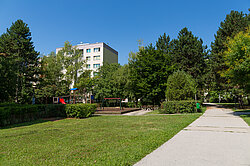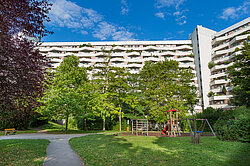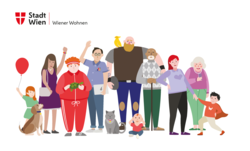PER-ALBIN-HANSSON-SIEDLUNG OST (PAHO)
Per-Albin-Hansson-Siedlung
Getting a large housing estate of the 70s fit for future!
>> The Per-Albin-Hansson-Siedlung is considered a model for social urban planning of the 1970s. Its qualities were as valid then as they are today. Now it's a matter of responding to current housing needs while safeguarding the existing qualities! <<
Kathrin Gaál, Vice Mayor & Councillor for Women and Housing
How can a large urban settlement from the 1970s be made fit for the future and adapted to today's housing needs? This is the central question that the IBA_Vienna addressed in the Per-Albin-Hansson-Siedlung Ost (PAHO) neighborhood. As the name suggests, the neighborhood includes the eastern section of the Per-Albin-Hansson-Siedlung, including the apartment block Olof-Palme-Hof. It extends from the underground station Alaudagasse in the west to Laaer-Berg-Straße in the east and from Alaudagasse in the north to Ada-Christen-Gasse with underground station Neulaa in the south..
Prototype of a 70s urban housing estate.
The residential blocks of the PAHO and the Olof-Palme-Hof were built between 1971 and 1976 using prefabricated concrete construction. The up to nine-storey buildings of the PAHO are aligned in parallel and arranged in groups. Between them are generous green spaces, numerous trees and shrubs, and a wide network of walkways. In accordance with the guiding principle of a "loosened and greened city," the conception focused on quiet, tranquil living as the main form of use. As a result, PAHO has very few sports and recreational facilities, commercial spaces, busy ground-floor zones, bike lanes, communication spaces, and other social infrastructure that are already standard in other modern developments. Follow the link to find out some hard facts about PAHO.
Object: Hard facts about PAHO.
Object: Innovations for Needs-Based Housing
"Are you satisfied with your living situation in PAHO? What should be improved in the settlement? How would you like to live in the future?" Questions like these were asked of PAHO residents in 2017. Based on the results and an extensive social space analysis, various fields of action were defined for which structural and social measures are being developed. The aim is to increase the quality of living for different target groups in PAHO. Diverse projects will be implemented by 2022, evaluated and checked on their replicability to other neighborhoods. PAHO thus becomes a laboratory for large housing estates of the 70s.
Six Fields of Action
Green Space:
Approx. 47% of those surveyed, especially parents and young people, would like the green spaces to be used more for leisure, sports and play. Older people want more seats on the paths to be able to take breaks. When redesigning open spaces, particular attention should be paid to the needs of girls.
Accessibility:
People over the age of 60 expressed an urgent need for improvements to the topic of accessibility in the entire housing estate, the possibility of accommodating walkers and walking aids, and the age-appropriate design of the apartment blocks. They would also like to see more housing offers and services tailored to senior citizens.
Mobility:
Approx. 44% of the residents use a bicycle and would like to have more bicycle storages. People up to 40 years are willing to try alternative mobility options, such as car sharing, bike rental, etc.
Neighborhood:
Many people want to have more neighborhood activities, such as neighborhood festivals. Good and affordable local care and sufficient specialists near the area of the housing estate are important to them.
Safety:
Many residents want better lighting of the routes through the housing estate and measures against burglaries, especially in the cellars. Badly visible corners and angles should be avoided.
Heat Protection:
In summers, many residents suffer from the heat, especially the elderly and mothers with young children. Diverse measures are suggested to cool down the apartments and create cool lounges outdoors.
Project completion
2022








